Resilient Buildings and Distributed Energy: A Grassroots Community Response to the Climate Emergency
Abstract
:1. Introduction
1.1. The Global Context
1.2. The Australian Context
1.3. Case Study Background
1.4. Research Objective and Research Questions
- Which countries or regions should Gippsland/the Latrobe Valley be comparing itself to, what can the region learn about disaster management and Emergency DES solutions?
- What energy services are supplied by these international examples (e.g., lights and appliances, refrigeration, hot water, heating, cooling, etc.)?
- What type/size of distributed energy resources (DER)/technologies have been integrated (e.g., solar PV, batteries of various chemistries, diesel generators, geothermal, small wind, electric vehicles, etc.)?
- What are the legal and regulatory challenges (e.g., who is responsible, how have they been managed elsewhere, etc.)?
- What other enablers are involved (e.g., supportive policy frameworks, close collaboration with local industries, local identity, etc.)?
2. Methods
2.1. Overview of the Research Design and Data Analysis
- The understanding of the Emergency DES concept developed by the community group Voices of the Valley in Victoria, Australia (empirical research);
- An assessment of domestic DES uptake in Australia, includes all states and territories (desktop research);
- An international market scan (broad overview of potential case study examples);
- The development of four international case studies demonstrating DES uptake in response to climate disasters. These case studies inform the proposed Emergency DES application in East Gippsland, Australia.
2.2. Methods Used to Assess the Case for Emergency DES in Australia
2.3. Methods Used to Select and Analyse International Examples of Emergency DES Applications
- A track record for innovation and technology development;
- Been impacted by extreme weather, environmental disasters, or similar over the last 20 years;
- Relevant distributed energy-related examples.
- Historical background;
- Technology/business model approach, i.e., deployment of the DES;
- High-level discussion of the target markets (beneficiaries from the technology uptake);
- Enablers, including specific policy measures and the extent to which Emergency DES other/distributed renewable energy resources contribute to the ‘identity’ of each region;
- Legal and regulatory issues;
- Stakeholders involved (where possible facilitating new network connections).
3. Results
3.1. Findings from the Literature Review
3.2. Findings from the Stakeholder Workshop
3.2.1. A Core Finding Was That Actor Diversity Is Key for Building Energy Resilience
3.2.2. Another Important Finding Was That Community Needs Must Inform the Vision of the Emergency Distributed Energy System Concept for Gippsland
3.3. Findings from the Semi-Structured Stakeholder Interviews
3.4. Findings from the PESTEL Analysis
3.4.1. Political Opportunities and Challenges
3.4.2. Economic Opportunities and Challenges
3.4.3. Social Opportunities and Challenges
3.4.4. Technical Opportunities and Challenges
3.4.5. Environmental Challenges and Opportunities
3.4.6. Legal Considerations
3.4.7. Who Should Invest in, Own, and Operate the Emergency DES?
3.4.8. What Electricity Industry Law and Regulation Applies?
3.5. Findings from the Case Study Comparison
3.5.1. Who Should the Latrobe Valley/Gippsland Be Comparing Itself to Regarding Emergency DES Responses?
3.5.2. Microgrid Adoption in California—Case Study Findings
3.5.3. Aegean Islands/Greece—Case Study Findings
3.5.4. Ganjam, India—Case Study Findings
3.5.5. Christchurch/South Island New Zealand—Case Study Findings
4. Discussion
- Different suites of technologies are available, and Emergency DES can gradually be upgraded or modified to meet and adjust to community needs;
- The size of the disaster-affected community and the scale of damage determines the technical response (microgrids might not be the quickest and most suitable solution at the time of recovery);
- Multi-level governance-style leadership assists the energy transition (administratively, financially, legally), and building climate resilience;
- Community engagement and consultancy processes are key to ensuring social acceptance and persistence of a microgrid (i.e., the organisation of maintenance and operation, community needs/various levels of income).
5. Conclusions
Limitations of the Study Design
Author Contributions
Funding
Institutional Review Board Statement
Informed Consent Statement
Data Availability Statement
Acknowledgments
Conflicts of Interest
Appendix A
| Country/Region | GII | Risk Level | Types of Hazard/Climate Extremes | Energy Relibability/Past Grid Impacts | DES Specialisation Drivers | Rationale |
|---|---|---|---|---|---|---|
| United States | 3 | High | Climatological (hurricane, wildfire) Geophysical Hydrological | In 2018, wildfire in California caused widespread outages. In 2012, Hurricanes Sandy and in 2005 Katrina led to major power outages. | DES: Leading microgrid market (especially ‘Sandy States’), West coast looking to follow in wake of wildfires. Visitor economy: examples of eco-tourism | For: commonality with wildfires, existing cooperation on disaster management, similar smart specialisation drivers to Latrobe Valley. Against: challenge to pick a single example from the US Suggestion: North America with focus on California and its DES response to the wildfire. |
| Europe | High | Low-Medium | Climatological (Portugal, Greece wildfire) Geophysical (Italy–earthquake) Hydrological (central-Europe—floods) | Pan-European floods (central/south Europe), southern European wildfire (Portugal, Greece, Spain, Italy); Earthquake (Italy, Greece) | DES: Examples of microgrids, although energy resilience is less of a driver (increased carbon reduction). Europe experienced major power outages. Italy had issues with battery telecoms back up during earthquake—needed longer duration. Other drivers: Vary among regions | For: high on innovation scale, leader in DES, varying type and propensity for disasters. Against: challenge to pick a single European example. Suggestion: Choice between Portugal (forest fires) or Greece (sustainable resilient islands). Additional research still being undertaken to narrow focus. |
| New Zealand | 25 out of ? | Low-Med. | Geophysical | 2011 Christchurch earthquake caused major destruction and led to long power outages. | DES: applied a ‘smart city’ approach for its rebuild; NZ becomes innovation & tech hub Visitor economy: used “containerised” shop units as tourist attractions, aim to improve liveability of city. Geothermal element in DES energy mix. | For: proximity to Australia, existing cooperation on disaster management, similar smart specialisation drivers to the Latrobe Valley. Against: Geophysical hazard different to wildfires. Suggestion: New Zealand is included; similar drivers and likelihood of building cooperation and links quickly. |
| India | 52 | High | Climatological (cyclone). Geophysical Hydrological | 2014 Cyclone affected the of Odisha leading to power outages. | DES: Project received funds from the Asian Development Bank; holistic approach Drivers: Internet of Things/IT-enabled DES, local RE resources, citizen-led) | For: investing in DES/IoT, high variety of and propensity for disasters, large potential market. Against: lower on innovation scale, high population density throughout despite large rural areas—quite different from regional Australian example. |
| Japan (Tohoku region) | 16 | Med.-High | Geophysical (earthquake/tsunami). Climatological (typhoons) Hydrological | 2011 earthquake/tsunami led to outages. Typhoons pose a more frequent threat. Grid is highly reliable otherwise | DES: High degree of innovation, microgrid examples show resilience to power outages during earthquakes/storms Visitor economy/geothermal: Onsen (spa) towns could provide insights for Latrobe Valley | For: innovative, industrially focussed economy with expertise in Emergency DES technology, examples of successful resilient systems. Against: could be some similarities with New Zealand and their response to their last major earthquake. |
| Indonesia | 85 | High | Geophysical Climatological Hydrological | 2004 Aceh tsunami saw distribution networks damaged for several months. Storms, floods, earthquakes lead to frequent power outages. | DES: lack of relevant examples from market scan, low rates of electrification. However, possible future drivers for this but faces challenges—frequent power outages, low access to electricity (in rural, less densely populated areas), underdeveloped distribution network, lack of inward investment in energy. | For: remote, low density population in parts. Against: lack of examples of Emergency DES activities compared with other shortlisted countries. This could be a useful future market but looks to be a lower priority market to undertake deeper dive research at this stage. |
References
- International Energy Agency. Net Zero by 2050: A Roadmap for the Global Energy Sector; International Energy Agency: Paris, France, 2021; Available online: https://www.iea.org/reports/net-zero-by-2050 (accessed on 6 September 2021).
- United Nations. Theme Report on Energy Transition—Towards the Achievement of SDG 7 and Net-Zero Emissions; United Nations: New York, NY, USA, 2021; Available online: https://www.un.org/sites/un2.un.org/files/2021-twg_2-062321.pdf (accessed on 12 November 2021).
- IPCC. Climate Change 2021: The Physical Science Basis. Contribution of Working Group I to the Sixth Assessment Report of the Intergovernmental Panel on Climate Change; Masson-Delmotte, V., Zhai, P., Pirani, A., Connors, S.L., Péan, C., Berger, S., Caud, N., Chen, Y., Goldfarb, L., Gomis, M.I., et al., Eds.; Cambridge University Press: Cambridge, UK, 2021. [Google Scholar]
- Bogdanov, D.; Ram, M.; Aghahosseini, A.; Gulagi, A.; Oyewo, A.S.; Child, M.; Caldera, U.; Sadovskaia, K.; Farfan, J.; Barbosa, L.D.S.N.S.; et al. Low-cost renewable electricity as the key driver of the global energy transition towards sustainability. Energy 2021, 227, 120467. [Google Scholar] [CrossRef]
- Johnstone, P.; Rogge, K.S.; Kivimaa, P.; Fratini, C.; Primmer, E.; Stirling, A. Waves of disruption in clean energy transitions: Sociotechnical dimensions of system disruption in Germany and the United Kingdom. Energy Res. Soc. Sci. 2019, 59, 101287. [Google Scholar] [CrossRef]
- Panteli, M.; Mancarella, P. Influence of extreme weather and climate change on the resilience of power systems: Impacts and possible mitigation strategies. Electr. Power Syst. Res. 2015, 127, 259–270. [Google Scholar] [CrossRef]
- Sanstad, A.H.; Zhu, Q.; Leibowicz, B.; Larsen, P.H.; Eto, J.H. Case Studies of the Economic Impacts of Power Interruptions and Damage to Electricity System Infrastructure from Extreme Events; Ernest Orlando Lawrence Berkeley National Laboratory: Berkeley, CA, USA, 2020. [Google Scholar]
- Hotaling, C.; Bird, S.; Heintzelman, M.D. Willingness to pay for microgrids to enhance community resilience. Energy Policy 2021, 154, 112248. [Google Scholar] [CrossRef]
- Komor, P.; Molnar, T. Background Paper on Distributed Renewable Energy Generation and Integration, Bonn, Germany. 2015. Available online: https://unfccc.int/ttclear/misc_/StaticFiles/gnwoerk_static/TEC_TD5/a4fd877135344ead9b22c4ff5e2d0184/1df38b6a7c2847deb251bdd3b0f75669.pdf (accessed on 4 September 2021).
- Collins, M.; Sutherland, M.; Bouwer, L.; Cheong, S.-M.; Frölicher, T.; Combes, H.J.D.; Roxy, M.K.; Losada, I.; McInnes, K.; Ratter, B.; et al. Extremes, Abrupt Changes and Managing Risk. In IPCC Special Report on the Ocean and Cryosphere in a Changing Climate; Pörtner, H.-O., Roberts, D.C., Masson-Delmotte, V., Zhai, P., Tignor, M., Poloczanska, E., Mintenbeck, K., Alegría, A., Nicolai, M., Okem, A., et al., Eds.; 2019; In press. [Google Scholar]
- Kopp, R.E.; Shwom, R.L.; Wagner, G.; Yuan, J. Tipping elements and climate–economic shocks: Pathways toward integrated assessment. Earth’s Futur. 2016, 4, 346–372. [Google Scholar] [CrossRef] [Green Version]
- Thackeray, S.J.; Robinson, S.A.; Smith, P.; Bruno, R.; Kirschbaum, M.U.F.; Bernacchi, C.; Byrne, M.; Cheung, W.; Cotrufo, M.F.; Gienapp, P.; et al. Civil disobedience movements such as School Strike for the Climate are raising public awareness of the climate change emergency. Glob. Chang. Biol. 2020, 26, 1042–1044. [Google Scholar] [CrossRef] [Green Version]
- Filkov, A.I.; Ngo, T.; Matthews, S.; Telfer, S.; Penman, T.D. Impact of Australia’s catastrophic 2019/20 bushfire season on communities and environment. Retrospective analysis and current trends. J. Saf. Sci. Resil. 2020, 1, 44–56. [Google Scholar] [CrossRef]
- Australian Government. Royal Commission into National Natural Disaster Arrangements Report, Canberra. 2020. Available online: https://naturaldisaster.royalcommission.gov.au/publications/royal-commission-national-natural-disaster-arrangements-report (accessed on 23 September 2021).
- Henderson, A. Federal Government Rejected Aerial Fire Fighting Requests ahead of Bushfires ‘Due to Other Priorities. ABC News, 15 August 2020. Available online: https://www.abc.net.au/news/2020-08-15/government-extra-air-support-ahead-of-bushfires/12554300?utm_campaign=abc_news_web&utm_content=link&utm_medium=content_shared&utm_source=abc_news_web(accessed on 3 November 2020).
- ABC News. Bushfires Relief Arrives in Mallacoota as Holidaymakers and Locals Register to Evacuate on HMAS Choules. ABC News, 2 January 2020. Available online: https://www.abc.net.au/news/2020-01-02/bushfire-relief-reaches-mallacoota-on-naval-ship/11837006(accessed on 10 March 2021).
- BBC. Australia Fires: A Visual Guide to the Bushfire Crisis. World News, 31 January 2020. Available online: https://www.bbc.com/news/world-australia-50951043(accessed on 20 August 2020).
- ABC News. Thousands of East Gippsland Residents and Holidaymakers Urged to Leave Ahead of Escalating Bushfire Danger. ABC News, 29 December 2019. Available online: https://www.abc.net.au/news/2019-12-29/people-told-to-leave-east-gippsland-as-bushfire-risk-rises/11831304(accessed on 22 July 2020).
- State Government of Victoria. “Past Bushfires”, Forest Fire Management Victoria. 2020. Available online: https://www.ffm.vic.gov.au/history-and-incidents/past-bushfires (accessed on 1 October 2021).
- Yüksel, I. Developing a Multi-Criteria Decision Making Model for PESTEL Analysis. Int. J. Bus. Manag. 2012, 7, 52–66. [Google Scholar] [CrossRef] [Green Version]
- Dutta, S.; Lanvin, B.; León, L.R.; Wunsch-Vincen, S. Global Innovation Index (GII) 2021; World Intellectual Property Organization (WIPO): Geneva, Switzerland, 2021; Available online: https://www.wipo.int/edocs/pubdocs/en/wipo_pub_gii_2021.pdf (accessed on 29 July 2020).
- International Federation of Red Cross. Types of Disasters: Definition of Hazard. 2020. Available online: https://www.ifrc.org/en/what-we-do/disaster-management/about-disasters/definition-of-hazard/ (accessed on 2 December 2021).
- UNISDR. Global Assessment Report on Disaster Risk Reduction; United Nations Office for Disaster Risk Reduction (UNDRR): Geneva, Switzerland, 2019; Available online: https://gar.undrr.org/ (accessed on 11 November 2021).
- UNFCCC. Technology Needs Assessment. 2021. Available online: https://unfccc.int/ttclear/tna (accessed on 10 December 2021).
- Holtmeyer, M.L.; Wang, S.; Axelbaum, R.L. Considerations for decision-making on distributed power generation in rural areas. Energy Policy 2013, 63, 708–715. [Google Scholar] [CrossRef]
- Zhu, Y.; Tong, Q.; Zeng, X.; Yan, X.; Li, Y.; Huang, G. Optimal Design of a Distributed Energy System Using the Functional Interval Model That Allows Reduced Carbon Emissions in Guanzhong, a Rural Area of China. Sustainability 2019, 11, 1930. [Google Scholar] [CrossRef] [Green Version]
- Cherni, J.A.; Dyner, I.; Henao, F.; Jaramillo, P.; Smith, R.; Font, R.O. Energy supply for sustainable rural livelihoods. A multi-criteria decision-support system. Energy Policy 2007, 35, 1493–1504. [Google Scholar] [CrossRef]
- Ajaz, W. Resilience, environmental concern, or energy democracy? A panel data analysis of microgrid adoption in the United States. Energy Res. Soc. Sci. 2018, 49, 26–35. [Google Scholar] [CrossRef]
- IPCC. Summary for Policymakers. In Climate Change and Land: An IPCC Special Report on Climate Change, Desertification, Land Degradation, Sustainable Land Management, Food Security, and Greenhouse Gas Fluxes in Terrestrial Ecosystems; Shukla, P.R., Skea, J., Buendia, E.C., Masson-Delmotte, V., Pörtner, H.-O., Roberts, D.C., Zhai, P., Slade, R., Connors, S., van Diemen, R., et al., Eds.; 2019; p. 472, In press. [Google Scholar]
- Ley, D. Sustainable Development, Climate Change, and Renewable Energy in Rural Central America. In Evaluating Climate Change Action for Sustainable Development; Uitto, J.I., Puri, J., van den Berg, R.D., Eds.; Springer: Cham, Switzerland, 2017; pp. 187–212. [Google Scholar]
- Siegel, J.R.; Rahman, A. The Diffusion of Off-Grid Solar Photovoltaic Technology in Rural Bangladesh, Medford, MA, USA. 2011. Available online: https://sites.tufts.edu/cierp/files/2018/02/SiegelRahman11SepSolarEnergy_Fsin.pdf (accessed on 11 November 2021).
- Dewald, U.; Truffer, B. The Local Sources of Market Formation: Explaining Regional Growth Differentials in German Photovoltaic Markets. Eur. Plan. Stud. 2012, 20, 397–420. [Google Scholar] [CrossRef]
- Gölz, S.; Wedderhoff, O. Explaining regional acceptance of the German energy transition by including trust in stakeholders and perception of fairness as socio-institutional factors. Energy Res. Soc. Sci. 2018, 43, 96–108. [Google Scholar] [CrossRef]
- Wheeler, N. Fire, Wind, and Waves: Grid Resilience Threats and Opportunities in California and New York, Berkeley. 2020. Available online: https://www.law.berkeley.edu/wp-content/uploads/2020/08/Resilient-Coasts-Naomi-Wheeler.pdf (accessed on 2 August 2021).
- Organization for Security and Co-Operation in Europe. Protecting Electricity Networks from Natural Hazards; Organization for Security and Co-Operation in Europe: Vienna, Austria, 2016; Available online: https://www.osce.org/files/f/documents/a/d/242651.pdf (accessed on 3 October 2021).
- Stephens, J.C.; Wilson, E.J.; Peterson, T.R.; Meadowcroft, J. Getting Smart? Climate Change and the Electric Grid. Challenges 2013, 4, 201–216. [Google Scholar] [CrossRef] [Green Version]
- Luft, R.E. Beyond Disaster Exceptionalism: Social Movement Developments in New Orleans after Hurricane Katrina. Am. Q. 2009, 61, 499–527. Available online: https://muse.jhu.edu/article/317270 (accessed on 12 October 2021).
- Hick, S.; Teplitsky, A. Internet Solidarity: Grassroots Movement Struggles for Human Rights. In Human Rights and the Internet; Hoskins, S., Hick, E.F., Halpin, E., Eds.; Palgrave Macmillan: London, UK, 2000; pp. 52–64. [Google Scholar]
- Fu, K.-W.; Chau, M. Use of Microblogs in Grassroots Movements in China: Exploring the Role of Online Networking in Agenda Setting. J. Inf. Technol. Politi. 2014, 11, 309–328. [Google Scholar] [CrossRef]
- Victorian Government. Latrobe Valley Authority. 2020. Available online: https://lva.vic.gov.au/about (accessed on 14 October 2020).
- Clean Energy Council. Clean Jobs Plan, Melbourne. 2020. Available online: https://www.climatecouncil.org.au/wp-content/uploads/2020/07/Climate-Council_AlphaBeta-Clean-Jobs-Plan-200720.pdf (accessed on 18 November 2021).
- Dawson, A. Climate Justice: The Emerging Movement against Green Capitalism. South Atl. Q. 2010, 109, 313–338. [Google Scholar] [CrossRef] [Green Version]
- MunichRe. Record Losses from the Black Summer Bushfires in Australia—Climate Change Is Partly to Blame, Wildfires. 2020. Available online: https://www.munichre.com/topics-online/en/climate-change-and-natural-disasters/natural-disasters/wildfires/black-summer-bushfires-in-australia.html (accessed on 14 July 2021).
- Sainty, L. ‘A Story of Hope’: How the Covid Downturn Could Help Australia Rebuild from Its Black Summer. The Guardian, 13 August 2020. Available online: https://www.theguardian.com/australia-news/2020/aug/13/a-story-of-hope-how-the-covid-downturn-could-help-australia-rebuild-from-its-black-summer?CMP=Share_iOSApp_Other(accessed on 10 February 2021).
- Birkmann, J.; Buckle, P.; Jaeger, J.; Pelling, M.; Setiadi, N.; Garschagen, M.; Fernando, N.; Kropp, J. Extreme events and disasters: A window of opportunity for change? Analysis of organizational, institutional and political changes, formal and informal responses after mega-disasters. Nat. Hazards 2008, 55, 637–655. [Google Scholar] [CrossRef]
- Sovacool, B.K.; Tan-Mullins, M.; Abrahamse, W. Bloated bodies and broken bricks: Power, ecology, and inequality in the political economy of natural disaster recovery. World Dev. 2018, 110, 243–255. [Google Scholar] [CrossRef]
- Burgess, K.; Canales, S.B. $1.2 Billion of $2 Billion Bushfire Fund Spent: Colvin. Canberra Times, 20 October 2020. Available online: https://www.canberratimes.com.au/story/6975567/12-billion-of-2-billion-bushfire-fund-spent-colvin/(accessed on 23 July 2021).
- Rojas-Zerpa, J.C.; Yusta, J.M. Methodologies, technologies and applications for electric supply planning in rural remote areas. Energy Sustain. Dev. 2014, 20, 66–76. [Google Scholar] [CrossRef]
- Feron, S. Sustainability of Off-Grid Photovoltaic Systems for Rural Electrification in Developing Countries: A Review. Sustainability 2016, 8, 1326. [Google Scholar] [CrossRef] [Green Version]
- AEMC. Updating The Regulatory Frameworks for Distributor-Led Stand-Alone Power Systems. 2020. Available online: https://www.aemc.gov.au/sites/default/files/documents/updating_the_regulatory_frameworks_for_distributor-led_stand-alone_power_systems_final_report_28_may_2020.pdf (accessed on 1 November 2021).
- Australian Institute for Disaster Resilience. Tasmanian Bushfires, 2018–2019, Australian Disaster Resilience Knowledge Hub. 2020. Available online: https://knowledge.aidr.org.au/resources/2018-19-bushfire-tas-tasmanian-bushfires/ (accessed on 6 January 2021).
- ARENA. King Island Renewable Energy Integration Project. 2011. Available online: https://arena.gov.au/projects/king-island-renewable-energy-integration-project/ (accessed on 9 July 2021).
- ARENA. Flinders Island Hybrid Energy Hub, Projects. 2014. Available online: https://arena.gov.au/projects/flinders-island-hybrid-energy-hub/ (accessed on 9 July 2020).
- Australian Energy Market Commission. Review of the Regulatory Frameworks for Stand-Alone Power Systems—Priority 1. 2019. Available online: https://www.ecdonline.com.au/content/electrical-distribution/news/saps-could-replace-poles-and-wires-in-remote-areas-1488448962#axzz5pwJRsImw (accessed on 1 August 2020).
- Government of Western Australia. Bushfire Overview, Department of Fire and Emergency Services. 2021. Available online: https://www.dfes.wa.gov.au/site/bushfire/overview.html (accessed on 1 November 2021).
- Western Power. Projects and Trials—Kalbarri Microgrid. 2020. Available online: https://westernpower.com.au/our-energy-evolution/projects-and-trials/kalbarri-microgrid/ (accessed on 28 June 2020).
- Pordage, C. Kangaroo Island Water Infrastructure Impacted by Bushfires. Utility Magazine, January 2020. Available online: https://utilitymagazine.com.au/kangaroo-island-infrastructure-impacted-by-bushfires/(accessed on 5 August 2020).
- Hornsdale Power Reserve. South Australia’ s Big Battery. 2020. Available online: https://hornsdalepowerreserve.com.au/ (accessed on 6 January 2021).
- Parkinson, G. Kangaroo Is. Loses Challenge to Network Plan That Threatens Renewables. RenewEconomy, May 2017. Available online: https://reneweconomy.com.au/kangaroo-is-loses-challenge-to-network-plan-that-threatens-renewables-55068/(accessed on 8 August 2020).
- Parkinson, G. Cutting the Cable: Kangaroo Island Eyes Switch to 100% Renewable Energy. The Guardian, 11 July 2016. Available online: https://www.theguardian.com/sustainable-business/2016/jul/11/cutting-the-cable-kangaroo-island-eyes-switch-to-100-renewable-energy(accessed on 9 August 2020).
- Wilson, A.; Esterhuysen, D.; Hains, D. The Business Case for Behind-the-Meterenergy Storage Q1 Performance of UQ’s 1.1 MW Tesla Battery, University of Queensland (UQ). 2020. Available online: https://sustainability.uq.edu.au/files/11868/EPBQtyRptq12020.pdf (accessed on 26 August 2020).
- Essential Energy. Our Network Area. 2020. Available online: https://www.essentialenergy.com.au/about-us/our-network-area (accessed on 6 January 2021).
- Victorian Government. Microgrids, Renewable Energy. 2020. Available online: https://www.energy.vic.gov.au/renewable-energy/microgrids (accessed on 12 November 2020).
- Victorian Government. Licola Wilderness Village. 2020. Available online: https://www.sustainability.vic.gov.au/About-us/Case-studies/Hospitality-and-services/Licola-Wilderness-Village (accessed on 9 November 2020).
- Critical Comms. Telecoms Operators Working to Restore Bushfire-Affected Networks. 2020. Available online: https://www.criticalcomms.com.au/content/public-safety/article/telecoms-operators-working-to-restore-bushfire-affected-networks-1336963770#axzz6fWNV8C6m (accessed on 1 December 2020).
- Victorian Government. Solar on Public Buildings Program. 2020. Available online: https://www.forestsandreserves.vic.gov.au/grants/solar-on-public-buildings-program (accessed on 14 September 2021).
- Victorian Government. A Safe and Quality Built-Environment, Department of Environment, Land, Water and Planning. 2021. Available online: https://www.delwp.vic.gov.au/corporate-plan/a-safe-and-quality-built-environment (accessed on 21 October 2021).
- Victorian Government. Community Recovery Committees. 2021. Available online: https://www.vic.gov.au/community-recovery-committees (accessed on 2 October 2021).
- NSW Government. Eco Schools: Energy, NSW Environmental Trust. 2019. Available online: https://www.environment.nsw.gov.au/funding-and-support/nsw-environmental-trust/grants-available/eco-schools/eco-schools-energy (accessed on 5 January 2021).
- Australian Academy of Health and Medical Sciences. The Australian Bushfires: Impacts on the Health—The Evidence. 2020. Available online: https://aahms.org/wp-content/uploads/2020/04/The-Australian-Bushfires-and-the-impact-on-health_evidence-doc.pdf (accessed on 11 November 2021).
- Duckett, S.; Mackey, W.; Stobart, A. The health effects of the 2019–2020 Bushfires. Submission to the Royal Commission into National Natural Disaster Arrangements, Melbourne. 2020. Available online: https://grattan.edu.au/wp-content/uploads/2020/04/Grattan-Institute-submission-to-Royal-Commission.pdf (accessed on 13 October 2021).
- Commonwealth of Australia, Commission into National Natural Disaster Arrangements. Chapter 9: Essential Services. 2020; pp. 1–22. Available online: https://naturaldisaster.royalcommission.gov.au/publications/html-report/chapter-09 (accessed on 24 February 2022).
- Cainey, J.M. Resilience and reliability for electricity networks. Proc. R. Soc. Vic. 2019, 131, 44–52. [Google Scholar] [CrossRef] [Green Version]
- Australian Government. Grant Award View—GA9588: A 6.48kW PV and Battery Storage System for the Murramarang Mens Shed, Grants. 2018. Available online: https://www.grants.gov.au/Ga/Show/b3fce391-0815-9969-28a6-57e73781fa99 (accessed on 20 October 2021).
- MicrogridKnowledge. Microgrid Kept Power on Even as the California Wildfires Caused Outages, October 2017. Available online: https://microgridknowledge.com/islanded-microgrid-fires/ (accessed on 5 June 2021).
- Energy Networks Australia. Bushfire Factsheet. 2020. Available online: https://www.energynetworks.com.au/resources/fact-sheets/bushfire-factsheet-2020/ (accessed on 11 July 2020).
- Williamson, G.; Mocatta, G.; Harris, R.; Remenyi, T. Yes, the Australian Bush Is Recovering from Bushfires—But It May Never Be the Same, Conversat. 2020, pp. 1–5. Available online: https://theconversation.com/yes-the-australian-bush-is-recovering-from-bushfires-but-it-may-never-be-the-same-131390 (accessed on 14 November 2021).
- Filatoff, N. Where There’s Smoke … There’s Reduced PV Output. PV Magazine, January 2020. Available online: https://www.pv-magazine.com/2020/01/21/where-theres-smoke-theres-reduced-pv-output/(accessed on 28 June 2020).
- Cranney, K.; Wilson, G. How Does Smoke, Dust and Hail Affect Solar Panel Performance? CSIRO Blog. 2020. Available online: https://blog.csiro.au/solar-panel-performance/ (accessed on 11 January 2021).
- Irwin, M. Social Access Solar Gardens, Sydney. 2018. Available online: www.uts.edu.au/news/social-justice-sustainability/can-solar-gardens-provide-access-affordable-solar-power (accessed on 23 October 2021).
- Wang, D.; Guan, D.; Zhu, S.; Mac Kinnon, M.; Geng, G.; Zhang, Q.; Zheng, H.; Lei, T.; Shao, S.; Gong, P.; et al. Economic footprint of California wildfires in 2018. Nat. Sustain. 2020, 4, 252–260. [Google Scholar] [CrossRef]
- Penn, I. PG & E Gives Wildfire Victims More Stock in Bankruptcy Plan. New York Times, 12 January 2020. Available online: https://www.nytimes.com/2020/06/12/business/energy-environment/pge-wildfire-victims-stock.html(accessed on 24 August 2020).
- Stone Edge Farm. Stone Edge Farm MicroGrid. 2021. Available online: https://sefmicrogrid.com/ (accessed on 13 January 2021).
- Santa Rosa Junior College. Sustainable SRJC, SRJC Micro Grid. 2020. Available online: https://sustainability.santarosa.edu/srjc-micro-grid (accessed on 11 November 2020).
- California Public Utilities Commission. Resiliency and Microgrids. 2021. Available online: https://www.cpuc.ca.gov/resiliencyandmicrogrids/ (accessed on 14 January 2021).
- Trevisiol, A. Only Wind, Sun and a ‘Slow’ Tourism. The Greek Tilos Is the First 100% Green Island of the Mediterranean. Ecobnb. 2019. Available online: https://ecobnb.com/blog/2019/03/tilos-green-island-mediterranean/ (accessed on 1 November 2021).
- Zoppi, L. A Greek Island That Runs on Renewable Energy. AZO CleanTech. 2018. Available online: https://www.azocleantech.com/article.aspx?ArticleID=810 (accessed on 15 August 2020).
- EU. A Remote Greek Island Is on Its Way to Becoming Energy Self-Sufficient, Scientific Advances. 2019. Available online: https://cordis.europa.eu/article/id/124099-a-remote-greek-island-is-on-its-way-to-becoming-energy-selfsufficient (accessed on 11 January 2021).
- European Parliament. Directive 2019/944 on Common Rules for the Internal Market for Electricity, Official Journal of the European Union. 2019. Available online: https://eur-lex.europa.eu/legal-content/EN/TXT/PDF/?uri=CELEX:32019L0944&from=EN%0Ahttp://www.omel.es/en/files/directive_celex_32019l0944_en.pdf (accessed on 29 July 2020).
- Mangalagiri, A.R. Smart Grids in Odisha, Odisha Power Transmission Corporation Limited. 2015. Available online: https://documents.pub/document/smart-grids-in-odisha-silicon-institute-of-grids-in-odisha-ananta-rao-mpdf.html (accessed on 5 November 2021).
- Orissa Daily. Odisha Power Transmission Corporation Limited Inks MOU with IIT Bhubaneswar. 2021. Available online: https://orissadiary.com/odisha-power-transmission-corporation-limited-inks-mou-with-iit-bhubaneswar/ (accessed on 3 March 2021).
- Gram Vikas. Maligaon Solar Energy Renewal Project Overview, Lakshmi Mittal and Family South Asia Institute at Harvard University (The Mittal Institute). 2019. Available online: https://mittalsouthasiainstitute.harvard.edu/wp-content/uploads/2019/07/project-to-revive-a-solar-micro-grid-in-Maligaon.pdf (accessed on 4 July 2020).
- Bretherton, J. Christchurch’s High Performance Rebuild. Procedia Eng. 2017, 180, 1044–1055. [Google Scholar] [CrossRef]
- Christchurch City Council. Christchurch Most EV-Friendly Town in NZ. 2019. Available online: https://newsline.ccc.govt.nz/news/story/christchurch-most-ev-friendly-town-in-nz (accessed on 12 January 2021).
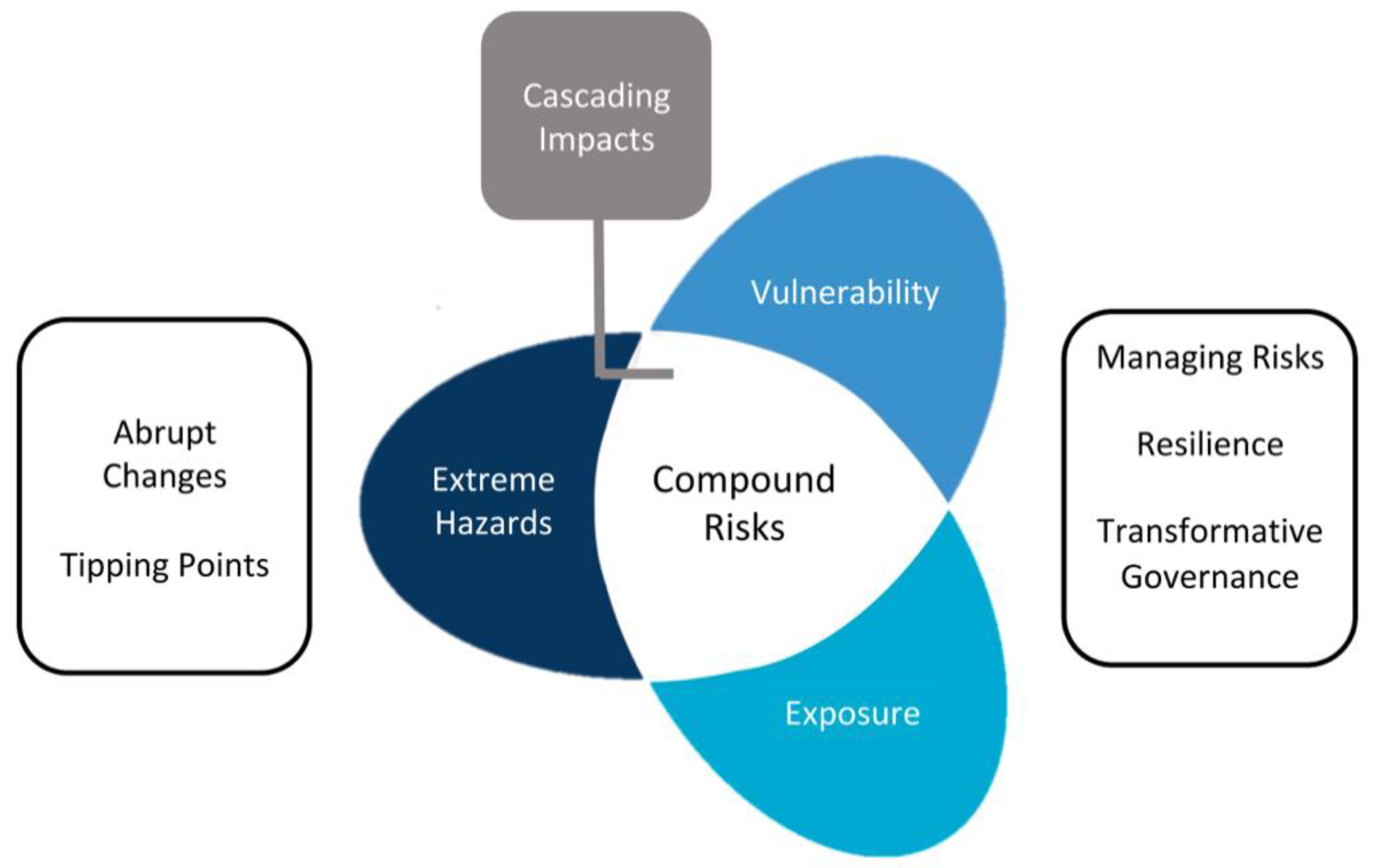

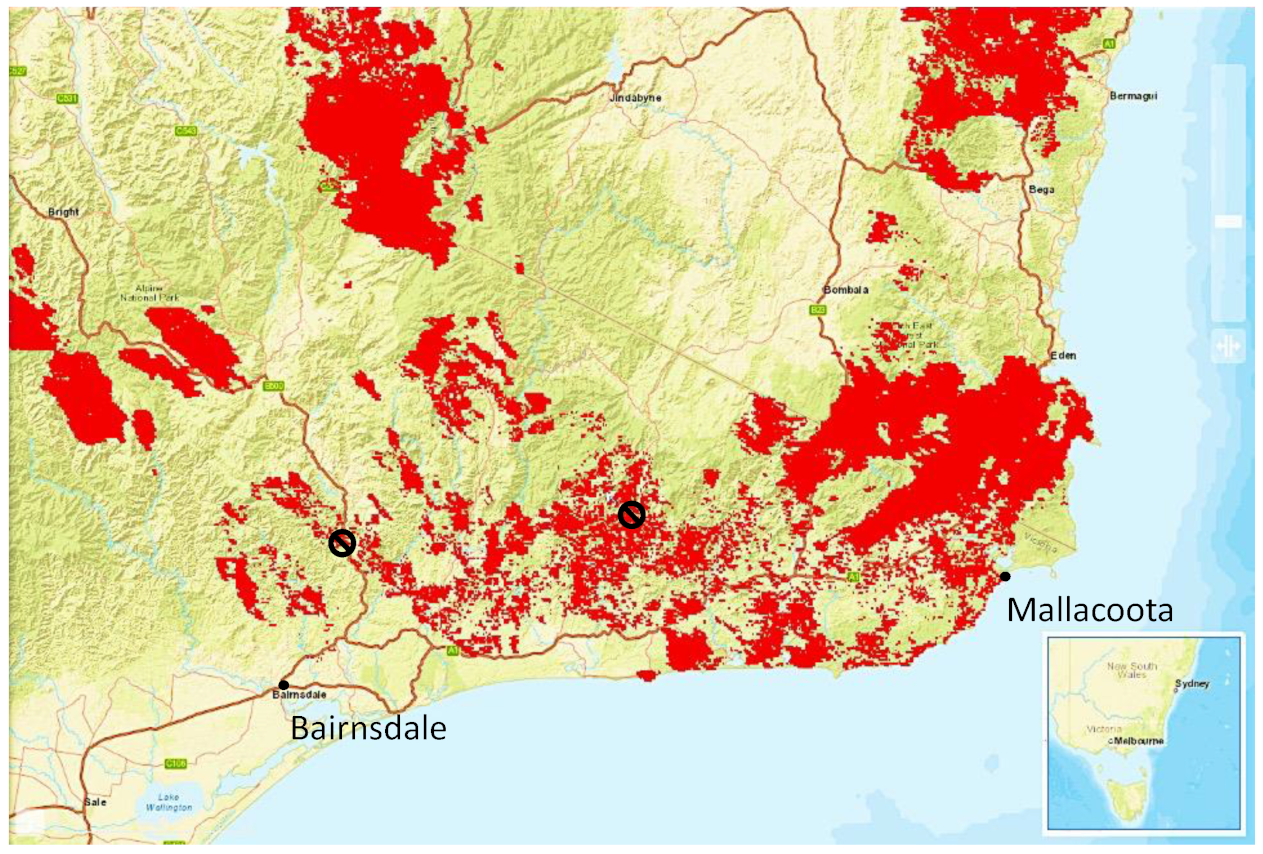

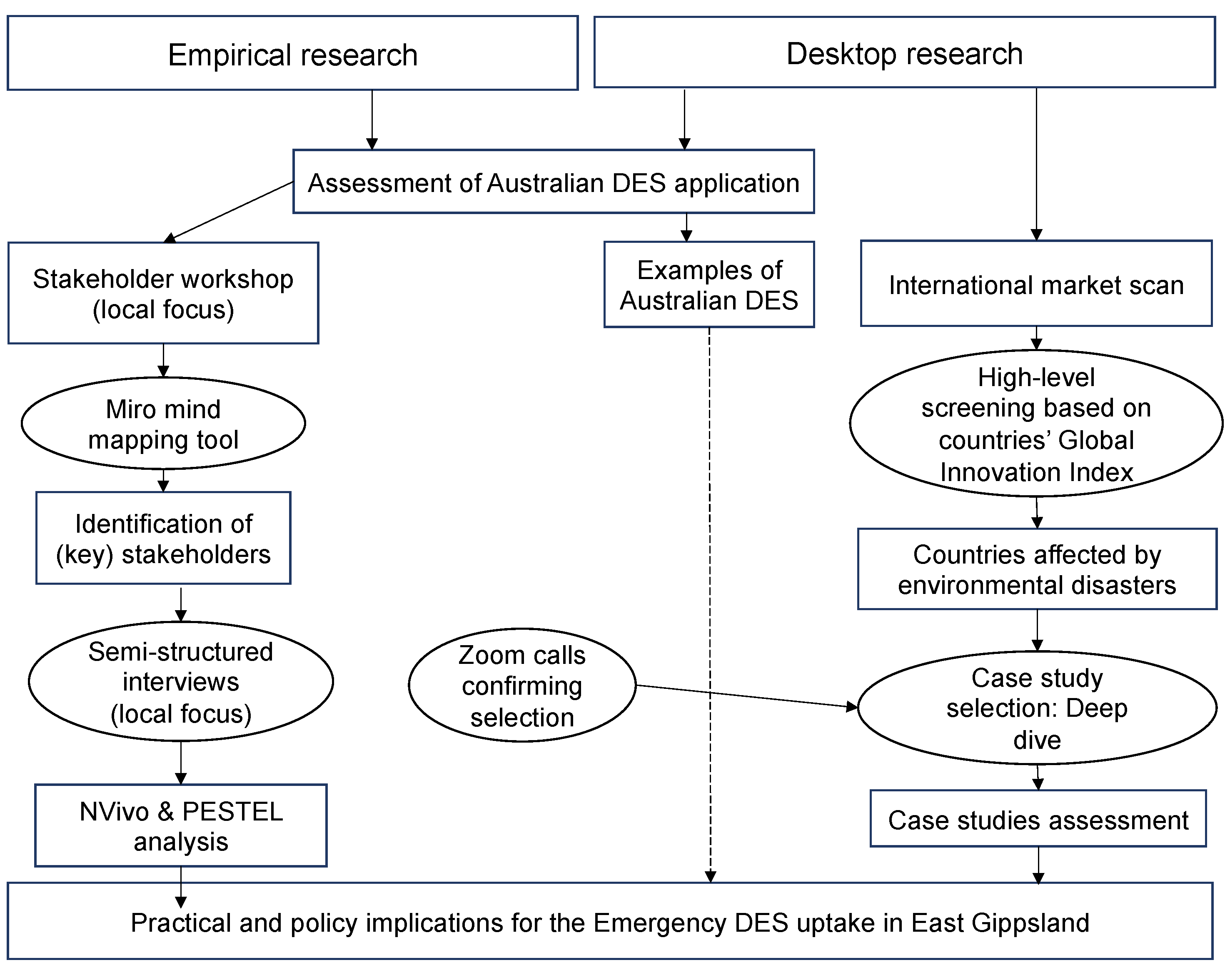
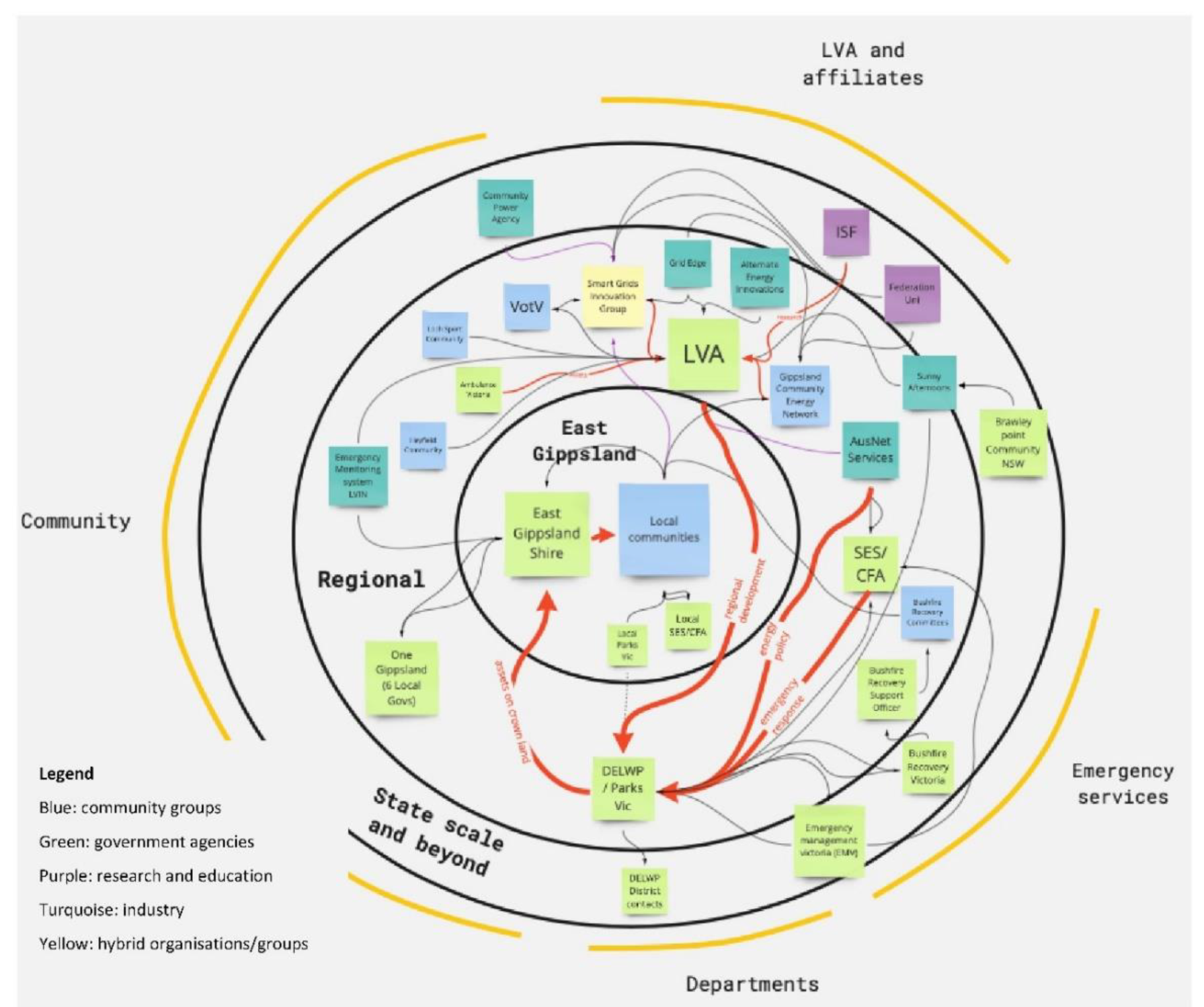
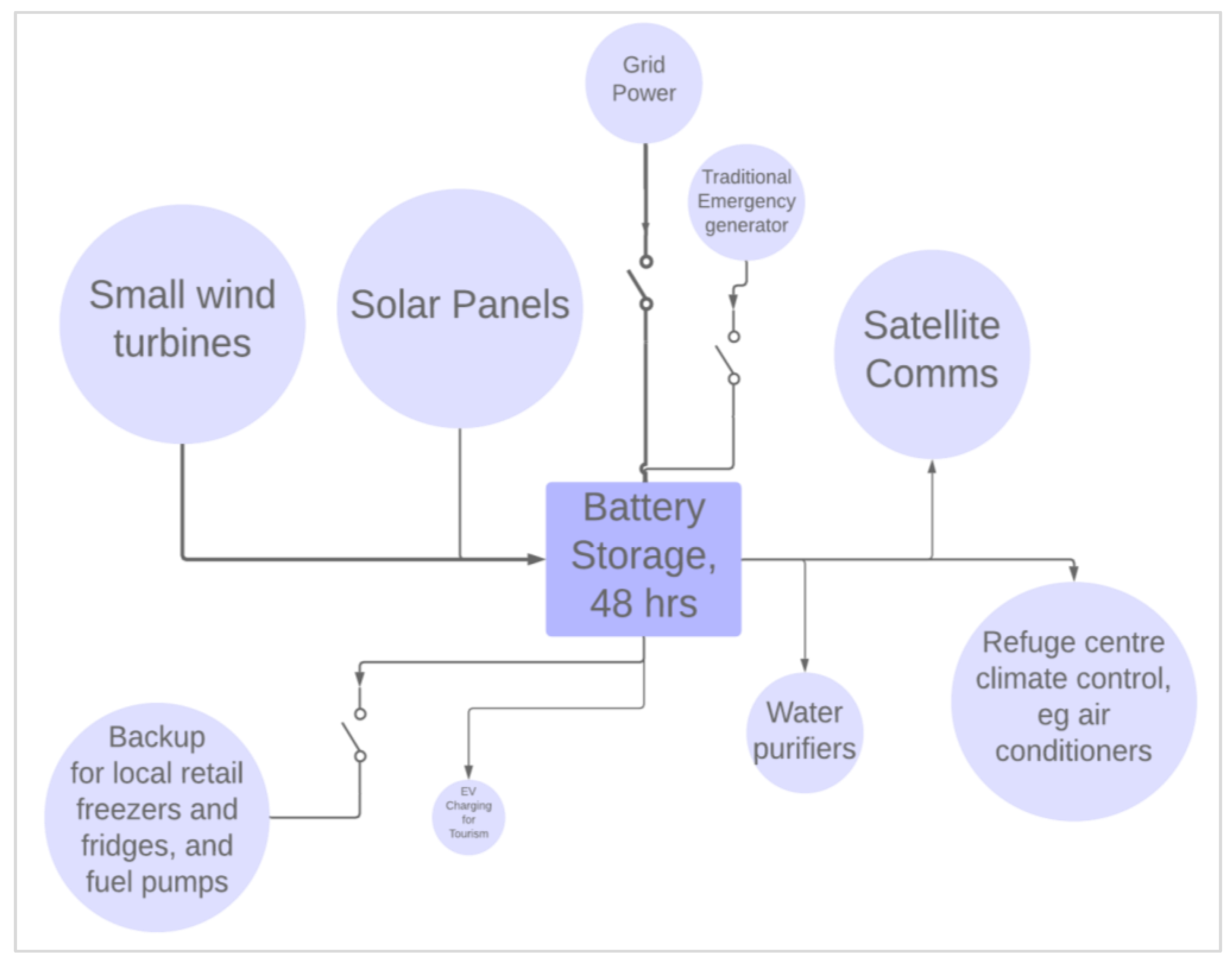
| Natural Hazard Categories | Natural Hazard Examples |
|---|---|
| Climatology | Hurricane, Typhoon, Cyclones |
| Extreme temperatures | |
| Wildfire | |
| Drought | |
| Winter storms | |
| Geophysics | Earthquake |
| Tsunami | |
| Landslide | |
| Volcanic activity | |
| Hydrology | Avalanche |
| Flood | |
| Technology or human-made | Environmental degradation |
| Pollution, industrial | |
| Travel accidents |
| State/Territory | Climate Impacts | Existing DES Projects | Potential for Stand-Alone Power Systems (SAPS) |
|---|---|---|---|
| Tasmania | 2018/19 wildfires [51] | King Island (2010–2016) and Flinders Islands (2014–2021) have been pioneering in DES uptake [52,53]. | TasNetworks has identified 5 possible SAPS sites over the next 5 to 10 years [54]. |
| Western Australia (WA) | Over 90% of WA is wildfire-prone [55] | A microgrid is also trialled in Kalbarri, a major tourist site [56] | Western Power, a state-owned energy company, has identified 15,000 potential DES sites until 2030 [54] |
| South Australia (SA) | 2019/20 Black Summer fires, Kangaroo Island was severely impacted [57] | 2017: The SA government installed a utility-scale Tesla battery storage system, the largest installation worldwide at the time. The battery capacity (129 MWh) is currently undergoing a 50% expansion [58] 2016: 100% RE proposal for Kangaroo Island was unsuccessful due to lack of support to remove the undersea network cable [59,60] | Two potential SAPS sites have been identified by the South Australian Power Network [54] |
| Queensland | 2019/20 Black Summer fires, and is at risk of extreme weather events | 2019: University of Queensland installed a Tesla battery system and showcases its economic and environmental benefits [61] | 1000–2000 potential sites have been identified for SAPS over the next 10 to 20 years [54] |
| Regional New South Wales | 2019/20 Black Summer fires | In the Essential Energy network there is potential for 2000 SAPS over the next decade [54]. The network covers 95% of NSW customers and parts of Southern Queensland [62] | |
| Victoria | 2019/20 Black Summer fires | Yackandandah (TRY) [63] and Licola Wilderness Village (located 50 km off the grid and 254 km east of Melbourne) has installed 600 solar panels and 2 large batteries [64] | The regulator identified 300–400 SAPS sites operated by AusNet Services [54], focused on Regional Victoria including East Gippsland |
| Facility Level | Intended Function | Operational Resources | Amenities | Equipment Requirements | Suitability for Emergency DES Concept |
|---|---|---|---|---|---|
| Municipal Self-sufficient/24-h activation (i.e., set up) time |
|
|
|
| Least suitable |
| District Self-sufficient/ 12-h activation time |
| Most suitable | |||
| Local 6-h activation period |
| Not specified | Meeting facilities
|
| Less suitable |
| External Factor | Opportunities | Threats/Challenges |
|---|---|---|
| Political |
|
|
| Social |
|
|
|
| |
| Technical |
|
|
|
| |
|
| |
| Environmental |
|
|
| Legal |
|
|
|
|
| Case Study Location | Proneness to Environmental Disasters | Evidence of Emergency DES | Specialisation Strategies (Community Energy, Sustainable Development, Bioenergy, Geothermal) |
|---|---|---|---|
| California/USA | X | X | X |
| Christchurch/New Zealand | X | X | X |
| Aegean Islands, Greece | X | X | |
| India, Odisha | X | X | X |
| Region | Type/Size of DES Technologies | Additional Enablers | Barriers, Including Legal and Regulatory Challenges | Lessons to Be Learned |
|---|---|---|---|---|
| California, Sonoma county (Stone Edge Winery only) |
|
|
|
|
| Aegean Islands/Greece |
|
|
|
|
| Ganjam district, State of Odisha/India (Maligaon Project only) |
|
|
|
|
| Christchurch/New Zealand |
|
|
|
|
Publisher’s Note: MDPI stays neutral with regard to jurisdictional claims in published maps and institutional affiliations. |
© 2022 by the authors. Licensee MDPI, Basel, Switzerland. This article is an open access article distributed under the terms and conditions of the Creative Commons Attribution (CC BY) license (https://creativecommons.org/licenses/by/4.0/).
Share and Cite
Niklas, S.; Alexander, D.; Dwyer, S. Resilient Buildings and Distributed Energy: A Grassroots Community Response to the Climate Emergency. Sustainability 2022, 14, 3186. https://doi.org/10.3390/su14063186
Niklas S, Alexander D, Dwyer S. Resilient Buildings and Distributed Energy: A Grassroots Community Response to the Climate Emergency. Sustainability. 2022; 14(6):3186. https://doi.org/10.3390/su14063186
Chicago/Turabian StyleNiklas, Sarah, Dani Alexander, and Scott Dwyer. 2022. "Resilient Buildings and Distributed Energy: A Grassroots Community Response to the Climate Emergency" Sustainability 14, no. 6: 3186. https://doi.org/10.3390/su14063186
APA StyleNiklas, S., Alexander, D., & Dwyer, S. (2022). Resilient Buildings and Distributed Energy: A Grassroots Community Response to the Climate Emergency. Sustainability, 14(6), 3186. https://doi.org/10.3390/su14063186








